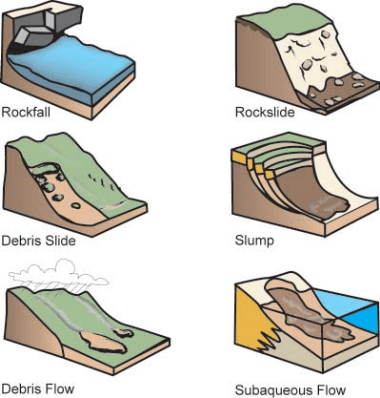Landslides are a serious geological hazard affecting the mountainous, volcanic islands of the Pacific region namely Fiji, Papua New Guinea, Samoa, Solomon Islands, Vanuatu and the Federated States of Micronesia.
Globally, landslides are more widespread than any other geological event and cause thousands of deaths and injuries each year and can cost billions in damages.
What is a Landslide?
Landslides occur when rock, soil or waste becomes unstable and moves downward under the influence of gravity. Many factors contribute to the instability of slopes, but the main factors that pre-dispose a slope’s stability are its geology, its geometry and its (pore)-water conditions.
Three distinct physical events occur during a landslide:
- Initial slope failure
- Subsequent transport
- Final deposition of the slide materials
Types of Landslides

- Falls & Topples: Often the result of weathering, a fall is the collapse of steep (usually rocky) slopes, while a topple occurs when material detaches from an exposed vertical face with a rotational outward movement.
- Slides: A slide occurs when material detaches from the slope and slides downwards along the slope in either a translational or rotational movement.
- Flows: During a flow, material moves like a liquid at speeds of about 10 m/s and travels long distances. These can be highly destructive due to their speed and ability to accumulate large chunks of debris, such as trees, vegetation, cars etc.
Landslides travel at a variety of speeds from a few millimeters a year to over 100 metres per second and are frequently associated with other natural hazards. Natural events and human activity can also cause slope failures.
Natural causes include:
- Saturation of slope material from intense/prolonged rainfall or seepage due to storms and tropical cyclones.
- Earthquake vibrations.
- Volcanic eruptions.
- Undercutting of cliffs and banks by waves or rivers etc. Human activities that cause landslides may include:
- Removal of vegetation or interference with or changes to natural drainage.
- Leaking pipes (water, sewer) or modification of slopes by construction of roads, railways or buildings.
- Mining activities and vibrations from heavy traffic or blasting and excavation or displacement of rocks. The steep, volcanic Pacific islands are particularly susceptible to landslides due to large amounts of rainfall, continual urban development and high earthquake potential and volcanic activity in the region.
Landslide Hazards
Landslides can be fast, sudden and can cover large areas, engulfing people, crops, animals and buildings. Areas prone to landslide hazards include old landslides, slopes dried out and cleared by fire, the bases of steep slopes, drainage channels and developed hillsides.
Fatalities and Damage
Landslides cause tremendous damage to property and infrastructure, as well as numerous fatalities and injuries.
One of the major problems is that landslides can cut off roads and communication lines, leaving people stranded. Landslides also affect the viability of food gardens and cash cropping areas on which rural Pacific economies are heavily dependent.
Secondary Effects Alteration of the landscape
Very large landslides can have an enormous effect on the surrounding geography. They create huge gaps in the vista and dam rivers, flooding surrounding areas and creating lakes.
Landslide dam outburst floods
Failure of a landslide dam, which has trapped large volumes of water behind it, can cause catastrophic flooding downstream.
Tsunamis
Large landslides underwater or into the sea may create tsunamis.
Reef damage
Landslides cause severe soil erosion and deposit this sediment in rivers, which then carry it into the sea causing considerable damage to the surrounding coral reefs.
Landslide Warning Signs
- • Doors or windows stick or jam for the fi rst time.
- • New cracks appear in plaster, tile, brick, or foundations.
- • Outside walls, walks, or stairs begin pulling away from the building.
- • Slowly developing, widening cracks appear on the ground or on paved areas and underground utility lines break.
- • Bulging ground appears at the base of a slope and water breaks through the ground surface in new locations.
- • Fences, retaining walls, utility poles, or trees crack, tilt or move and boulders knock together.
- • You hear a faint rumbling sound that increases in volume as the landslide nears.
- • The ground slopes downward in one specific direction and may begin shifting in that direction under your feet If you are near a stream or channel, be alert for any sudden increase or decrease in water flow and for a change from clear to muddy water.

